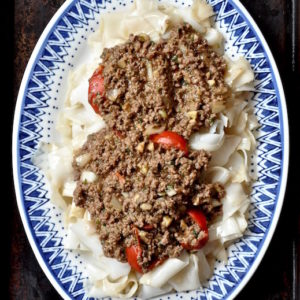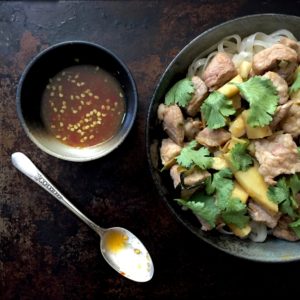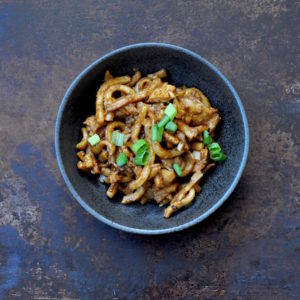Rice Noodles at home
I’ve read that people who have a “hand” for bread baking will find noodle making a breeze. Those pretty little pleats keeping Asian dumplings closed? Just a matter of practice.

My noodles–Asian or otherwise–range from barely edible to disastrous. To call my attempts at pleating childlike is an insult to children everywhere.

Nevertheless, just as it was once embarrassing to be a blogger who was unable to bake, it is now embarrassing to be a blogger who is unable to noodle.

(We now live in a world where people feel perfectly free to use slang like “unfussy,” “hangry,” and “cray” in printed matter. So if I want to noodle, with all due respect to Strunk And White, noodle I will.)

Given the extensive selection of excellent premade noodles out there–fresh, semi-fresh, and frozen– it is arguable that acheiving homemade noodle greatness isn’t all that necessary.

Nevertheless, homemade noodles are much like homebaked bread: chewy, flavorful, suffused with the glow of achievement.
This recipe comes from Jeffrey Alford and Naomi Duguid’s Beyond The Great Wall: Recipes And Travels In The Other China.
My noodles are a very long way from perfect. They’re, you know, a process. Which is another way of saying if I can make these, anybody can.

Handmade Rice Noodles
From Beyond The Great Wall: Recipes And Travels In The Other China
By Jeffrey Alford and Naomi Duguid
Prep time: the noodle dough needs at least an hour’s resting time.
Serves: 2-4 people
Ingredients
2 cups rice flour
1/2 teaspoon salt
1 cup boiling water
2 tablespoons peanut, canola, or sunflower oil for the dough, plus more oil for the counter and your hands
sesame oil, for finished noodles
Two optional dipping sauces:
The first:
approximately 1/2 cup soy sauce
approximately 1/2 cup black or brown rice vinegar
very finely shredded fresh ginger
The second:
2 tablespoons Asian fish sauce
fresh lime juice to taste
a small, finely minced garlic clove
dried chile pepper to taste
Optional condiments to serve with noodles:
Asian Chile Paste
Soy sauce
Sesame oil
Hot chile oil
thinly sliced scallion, green parts only
Mix the flour and salt together in a large bowl. Add the boiling water and mix with a wooden spoon. Add the oil and either knead in the bowl or dump out onto an immaculately clean countertop (my preference) and knead until you have a stiff dough. It will be much tighter than bread dough. Wrap in plastic wrap and allow to rest 1-3 hours at room temperature.
To roll the noodles, set out a large platter or baking tray. Bring a large pot of water to boil, turn it down to a simmer, and cover it if possible.
To form the noodles:
Oil your palms with cooking oil. You may need to repeat this step, so keep the oil nearby, or follow Alford and Duguid’s suggestion and oil a piece of paper towelling, and reuse it.
Pick a teaspoon-sized piece of dough from the larger dough ball. Roll the small piece between your palms to form a ball.
Once you have a ball, start pressing your palms together, rolling the dough back and forth all the while. Alford and Duguid write that the dough ball will lengthen, becoming about three inches long, with tapering ends and a bulging middle.
I must have strange palms. My noodles never taper, instead looking like slugs. Whatever your noodle looks like, once it’s about three inches long, place it on the tray.
Re-oil your hands if necessary, and repeat until all your dough is used up. This happens quickly. Resist the temptation to pluck big pieces of dough off the mother dough ball.
Once all the noodles are rolled, bring the water to vigorous boil. Really crank the heat up, or your noodles won’t cook properly.
When the water is at a rollicking boil, slide the noodles into the pot. They’ll sink, then rise. Once they’ve risen, allow them to cook a few more minutes. They’ll sink again when they’re ready. Taste to be sure.
Skim the cooked noodles into a bowl with a ladle or Chinese spider. Drizzle sesame or peanut oil over the noodles.
Noodles will hold at room temperature for an hour or two, but are truly at their best served immediately. We had leftovers, which John finished the next day.
Serve noodles with dipping sauces and condiments. Eat them alone, or as part of a multicourse Asian meal.





